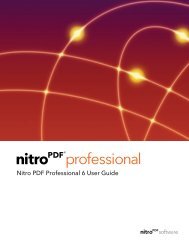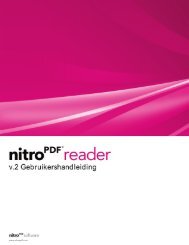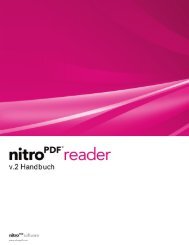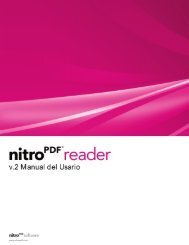Nitro PDF Professional User Guide
Nitro PDF Professional User Guide
Nitro PDF Professional User Guide
Create successful ePaper yourself
Turn your PDF publications into a flip-book with our unique Google optimized e-Paper software.
© 2008 <strong>Nitro</strong> <strong>PDF</strong> Software<br />
To import comments into a <strong>PDF</strong>:<br />
10. Security<br />
1. On the Review tab, in the Review group, click Migrate .<br />
2. Click Import Comments.<br />
3. Select the same file that contains different comments in it.<br />
Commenting 61<br />
With <strong>Nitro</strong> <strong>PDF</strong> <strong>Professional</strong> you can secure your <strong>PDF</strong> files with password- or certificate-based security, and<br />
once secured, your <strong>PDF</strong>s are protected with high-level 128-bit RC4 or 128-bit AES encryption.<br />
You can apply two different sorts of security to control who can access your files and what they can do with<br />
the files when they receive them:<br />
· Open file. This security locks a file so that only users with the correct ‘key’ can open the file.<br />
Depending on the type of security you use, only users with the correct password, or an approved<br />
digital ID will be able to open and view the file.<br />
· File usage permissions. This security can lock (or turn off) particular functionality once a <strong>PDF</strong> file is<br />
opened. For example, you could disallow users from printing or copying text from the <strong>PDF</strong>. This type<br />
of control of document usage works particularly well for certificate-based security as you can allow<br />
different usage on a recipient-by-recipient basis.<br />
To view the security in a file:<br />
1. Click the <strong>Nitro</strong> <strong>PDF</strong> Button, and then click Document Properties.<br />
2. Click the Security tab.<br />
10.1 Permission settings<br />
The usage permission settings let you restrict what features can be used when a recipient opens a file you<br />
have secured. This means, for example, that you can distribute documents that can’t be edited or printed,<br />
but can be opened and viewed. Using these permission settings with digital ID certificate-based security<br />
gives you even greater flexibility as you can set different permissions for each individual recipient of your<br />
file.<br />
The usage permissions you can control include:<br />
· Printing. Control the user’s ability to print the document, and at what resolution quality.<br />
· Modify document. Control the user’s ability to edit the contents of a document.<br />
· Content copying or extraction. Control the user’s ability to copy content from a document.<br />
· Content accessibility enabled. Control the user’s ability to use accessibility tools to access <strong>PDF</strong><br />
documents.<br />
· Commenting. Control the user’s ability to add notes, text highlights, and drawing markups.<br />
· Form field fill-in or signing. Control the user’s ability to fill in forms and digitally sign documents.<br />
· Document assembly. Control the user’s ability to insert pages into and extract pages out of <strong>PDF</strong><br />
documents.<br />
· Access for screen readers. Allow text to be accessed by screen-reading software for users with a<br />
visual impairment.

















